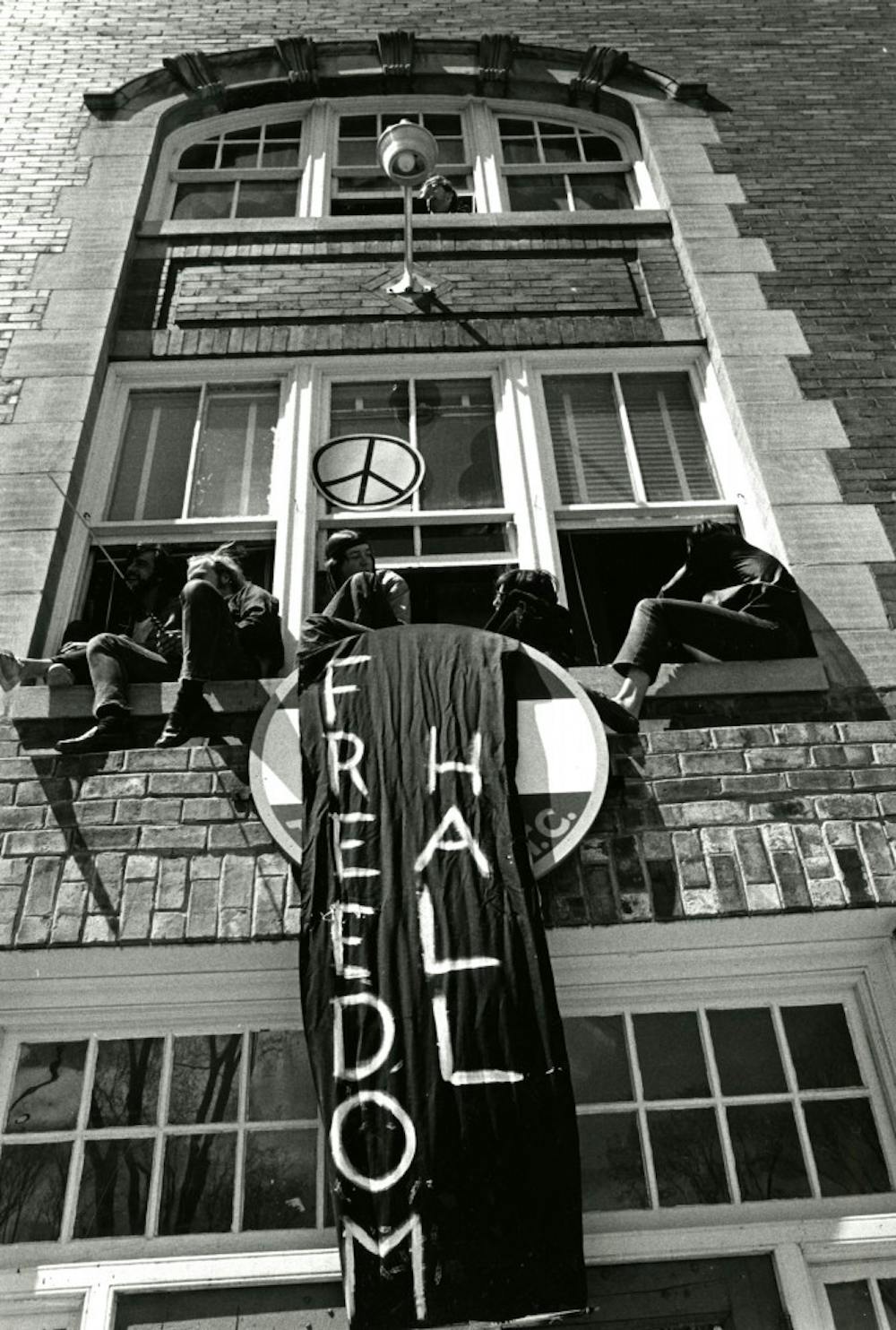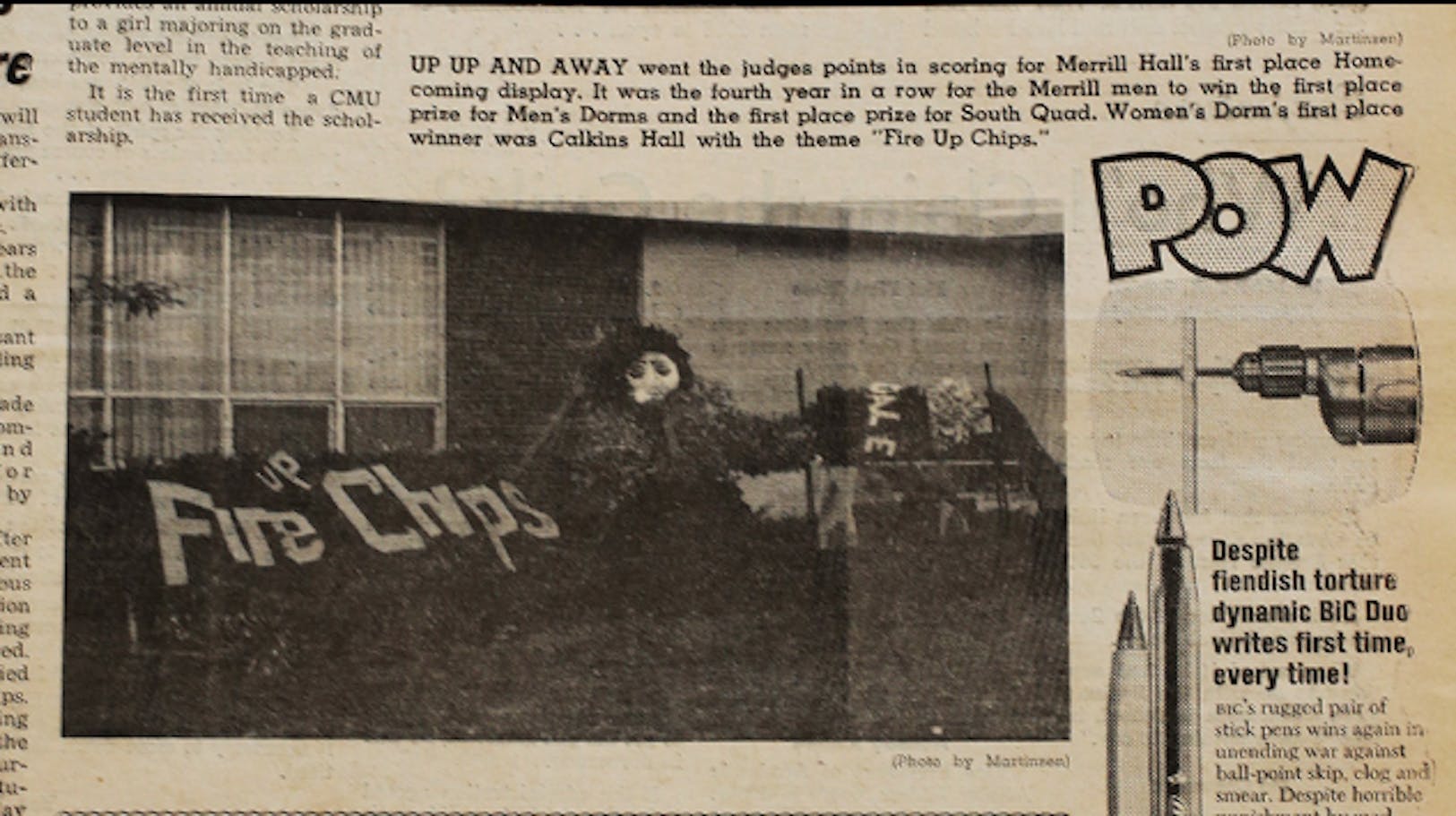History of student life at Central Michigan University trends toward becoming more unified, philanthropic

Students occupy Central Hall, home of the ROTC program, and rename it Freedom Hall on May 5, 1970 after the SGA called for campus wide demonstrations after the U.S. invasion of Cambodia and the death of student protestors at Kent State.
With the first men's residence halls on campus not appearing until 1939, some of the first male students at Central Michigan University ended up biking 60 miles to attend classes at a school then known as Central Normal College.
This is all according to Bryan Whitledge, archivist with University Digital Records, who's spent countless hours poring over school records to compile a timeline spanning the 125 years CMU has been established. The interactive timeline features administrative facts, student life and pop culture happenings and lays out our storied past.
Over the course of the university's 125-year history, student life has evolved from campus serving as only a place for students to get an education. It has become a hub to meet people with different life experiences, exercise First Amendment rights and a place that encourages students to evolve into more philanthropic, charitable people.
"There's a lot that can be learned from the student life experience that is really beneficial to the average university student, even though there's nothing that says you have to in written curriculum," Whitledge said. "For someone who's 18 or 19 years old, all you've ever done is live with your parents or someone who's used to your living habits prior to coming to college.
"Student life — that's a really big experience."
Central's Inception
When the university started as Central Normal School in May 1892, there were no residence halls. Students were forced to live in rented, off-campus housing or commute.
When the first residence halls started appearing, they were typically reserved for women.
"Getting to (CMU) was tough," Whitledge said. "We start before automobiles are really big so you're probably getting here by train. And, there wasn't even really a direct train line to here."
The school was more reserved and rigid than it is now, falling in line with social norms expected in the early 1900s. Dancing wasn't allowed until 1905 and Greek letter organizations were removed from campus in 1915 for fear of creating a hostility between students from the Mount Pleasant area and students coming to CMU from larger cities.
While we know much about student life from CMU's early days, not much is recorded when compared to administrative facts and dates of the time.
We didn't play Western Michigan University until 1907. We drop football as the school sport for soccer in 1913 citing "a lack of heavy men," and possibly funding, according to the university's timeline. The school had seven men die in World War I.
In the 1920s CMU begins to show the early signs of becoming the campus students know it as today. This involves establishing a date for a fall Homecoming — the first of which takes place on Nov. 24, 1924 — opening the first on-campus residence hall later that year and opening Warriner Hall in 1928.
Greek letter organizations are also reintroduced in 1939 with the turn of a new university administration.
"The previous administration had been allergic to Greek letters," then professor E.C. Beck mockingly remarked, as reported by the Clarke Historical Library.
This occurs just before we drop our decade long use of the mascot the Bearcat.
Once the university begins associating with the name Chippewas, though not with the sanction of the Saginaw Chippewa Indian Tribe, CMU enters an era that sets the tone for today's students. This is punctuated by activism, technological advancement and the philanthropy which holds true today.
The decades that set the tone
Between the 1950s and 70s at CMU was a time bogged down by two different wars, the Vietnam and Korean wars, and the aftermath of another — World War II.
It would be those wars, subsequent anti-war movements and a shift in the types of professors CMU hired that created a spirit which spawned campus wide protest and charity efforts alike.

"It's around (the 1960s) that students begin demanding they be treated like equals," he said. "By the end of the 1960s we go through a lot of growing pains, shifting from a regional state teacher’s college to a university. The model of the university we see today, the student life we know of today, they really start building up in the 50s and 60s."
In the early 60s, students kicked off their decades-long protesting sprees by protesting disagreements between students, staff and faculty on campus. This resulted in a campus-wide march to the then president of the university's home, his residency being stoned and a subsequent Michigan Senate investigation into campus on-goings.
After a special committee investigated the university, on April 1, 1965 the Michigan Senate finds "a university with low tolerance for criticism or disagreement," and tasked CMU with creating a "new, vigorous and dynamic" university administration, according to the university's timeline.
"We see a lot of things changing after World War II," Whitledge said. "We start seeing married housing — the university never had to build that. We have students who are in their late 20s and have seen some serious violence in the war. That's not something the university was thinking about, or prepared for."
Even on a small scale, things were changing. Until the 60s and into the 70s, women at CMU had a curfew placed on them and had to be back in their residence hall at a certain time. Men did not. This was an offense punishable by detention or some other type of university reprimanding, Whitledge said.
"When (the administration) finally says, 'women don't have to verify they were in their room at x time,' that's a really big moment," he said. "A lot of the women students who were here at that time say as small as it was, it was the first time most all was equal (between the genders) on campus."
Then came the anti-Vietnam War protests in May 1970, spurred on by the shooting at Kent State University that killed four unarmed students in Ohio. CMU students occupied Central Hall, then the building which housed the ROTC program, and dubbed it Freedom Hall.
While many people called on then CMU President William Boyd to also call in the National Guard to disperse the campus confusion, Boyd was resolute in letting students peter out the protests themselves, Whitledge said.
The protests eventually did die down, with no injuries reported or damages to campus Whitledge said.
"CMU's protesting (during the Vietnam War) was atypical for two reasons," he said. "First, you had an administration that didn't mind the protesting — in fact, they supported it and student's freedom to think. And we didn't have violence on this campus, we just didn't. We had a president who understood what causes and what diffuses conflict."
Protesting isn't all the two decades would see at CMU, with a wave of volunteerism and philanthropy becoming a driving force on campus in 1960 through the 70s. During this time, the university saw the first real footnote of campus-wide volunteerism, kickstarted by student veterans of the Korean War.
The goal was to raise money for the Mun San Orphanage in now South Korea through the Korean Orphanage Committee. By the time the effort died down, the group had raised more than $20,000, according to a CMU News press release. Today, that would be more than $164,000.
While the Mary Ellen Brandell Volunteer Center wouldn't come to fruition until 1992, more than 30 years after the Korean orphanage efforts, Whitledge said the spirit of philanthropy at CMU is evident when he looks back at university history.
Learn from the past, better the future
For CMU's more recent history, spanning from the 1980s until today, Tony Voisin is a pretty good person to ask — he's been a part of the university as a student and faculty member for almost 30 percent of its history.
As vice president of Student Affairs, Voisin said he's noticed the culture of caring continues well on into today's CMU. It's also when the university finalizes several key aspects of campus students today are familiar with: we host our first Powwow in April 1989 and stop using Native American imagery to define the school later that year; we play our first football game at night in 1993; we expand from five to eight academic colleges in 1998.
Being able to watch the growth and development of student life since his freshman year in 1980, Voisin said he's critical of the recent notion today's students are less involved than decades past.
"In the 80s, we were students that were pretty apathetic. We were more about 'me' than this generation is," Voisin said. "Activism was not something we were concerned about, and neither was speaking our mind or volunteering. We grew up with the race riots and Vietnam, and I think when we got to college, people didn't really have a cause.
"Over the years, I've seen students become more active, passionate and more concerned about making a difference in the world they live in. That's huge."
When looking toward the future of student life both Whitledge and Voisin don't know what's in store for CMU. Trends seem to suggest the university moving away from being known as a teacher's college and is now classified as a doctoral research university by the Carnegie Classifications of Universities.
That doesn't mean the grit of our students will change, Whitledge said.
"Since the Mun San orphanage, our volunteerism has continued since then and it's just been so impressive," Whitledge said. "There are a lot of people here who are doing really amazing things, and they don't do it for recognition.
“The whole 'put your stamp on the world' slogan — these people aren't putting their stamp on the world, they're putting their anonymous stamp on CMU, which makes us better in the world."



